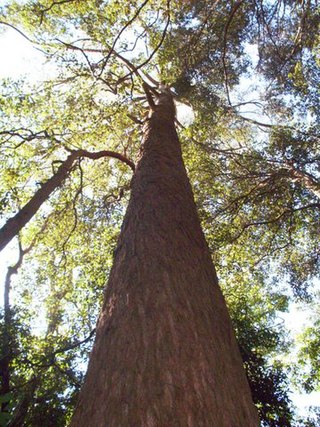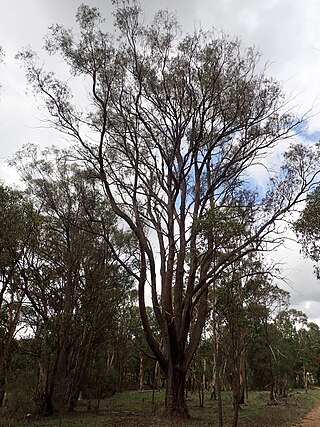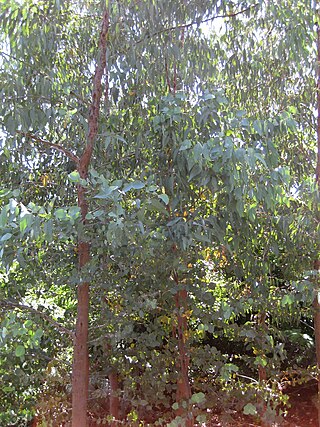
Eucalyptus macrorhyncha, commonly known as the red stringybark, is a species of medium-sized tree that is endemic to eastern Australia. It has rough, stringy, grey to brown bark, lance-shaped adult leaves, flower buds in groups of between seven and eleven, white flowers and hemispherical fruit.

Eucalyptus muelleriana, commonly known as yellow stringybark, is a species of medium-sized to tall tree that is endemic to southeastern Australia. It has rough, stingy bark on the trunk and branches, lance-shaped to curved adult leaves, flower buds in groups of between seven and eleven, white flowers and cup-shaped to shortened spherical fruit.

Eucalyptus capitellata, commonly known as brown stringybark, is a species of tree that is endemic to New South Wales. It is a small to medium-sized tree with rough, stringy bark from the trunk to the thinnest branches, lance-shaped to curved adult leaves, spindle-shaped or oblong flower buds in groups of seven or more, white flowers and clusters of flattened hemispherical fruit.

Eucalyptus baxteri, commonly known as brown stringybark, is a medium-sized tree that is endemic the south-east of Australia. It has rough, stringy bark to the thinnest branches, lance-shaped or curved adult leaves, green to yellow flower buds in groups of between nine and fifteen, and cup-shaped or hemispherical fruit.

Eucalyptus caliginosa, commonly known as broad-leaved stringybark or New England stringybark, is a tree that is endemic to eastern Australia. It has stringy bark, lance-shaped or curved adult leaves, flower buds in groups of seven or nine, white flowers and more or less hemispherical fruit. It is common on the Northern Tablelands and North West Slopes of New South Wales and adjacent areas of Queensland.

Eucalyptus fastigata, commonly known as brown barrel or cut-tail, is a species of medium-sized to tall tree that is endemic to southeastern Australia. It has fibrous or stringy bark on the trunk and larger branches, smooth bark above, lance-shaped to curved adult leaves, flower buds in groups of eleven or more, white flowers and conical or pair-shaped fruit.

Eucalyptus laevopinea, commonly known as the silver top stringybark, is a tree that is endemic to eastern Australia. It has rough, stringy greyish bark on the trunk and larger branches, glossy green, lance-shaped adult leaves, flower buds in groups of between seven and eleven, white flowers and hemispherical or shortened spherical fruit.

Eucalyptus blaxlandii, commonly known as Blaxland's stringybark, is a tree that is endemic to south eastern New South Wales. It is a stringybark with lance-shaped adult leaves, flower buds arranged in group of nine or eleven, white flowers and hemispherical fruit.

Eucalyptus ligustrina, commonly known as the privet-leaved stringybark, is a species of shrub, mallee or small tree that is endemic to New South Wales. It has rough, stringy bark, lance-shaped to egg-shaped adult leaves, flower buds in groups of between seven and fifteen, white flowers and hemispherical or shortened spherical fruit.

Eucalyptus cameronii, commonly known as the diehard stringybark is a flowering plant that is endemic to eastern Australia. It is a small to medium-sized tree with rough, stringy bark from the trunk to the small branches, lance-shaped to curved adult leaves, flowers buds in groups of between nine and fifteen, white flowers and cup-shaped, hemispherical or more or less spherical fruit. It mainly grows on the eastern side of the Northern Tablelands in New South Wales.

Eucalyptus planchoniana, commonly known as the needlebark stringybark or bastard tallowwood is a species of small to medium-sized tree that is endemic to eastern Australia. It has rough, stringy bark on the trunk and larger branches, lance-shaped to curved adult leaves, flower buds in groups of seven, white flowers and cup-shaped, cylindrical or barrel-shaped fruit.

Eucalyptus youmanii, commonly known as Youman's stringybark, is a species of small to medium-sized tree that is endemic to eastern Australia. It has rough, stringy bark on the trunk and branches, lance-shaped or curved adult leaves, flower buds in groups of seven, white flowers and hemispherical fruit.

Eucalyptus alligatrix, commonly known as the silver stringybark, is a tree endemic to southeastern Australia. It has rough, fibrous bark on the trunk and branches, lance-shaped adult leaves, flower buds usually arranged in groups of three, white flowers and cup-shaped, bell-shaped or cone-shaped fruit.

Eucalyptus baileyana, commonly known as Bailey's stringybark, is a tree endemic to near-coastal areas of eastern Australia. It has rough, stringy bark on its trunk and main branches, lance-shaped adult leaves, flower buds in groups of seven, white flowers with stamens in four bundles and urn-shaped to more or less spherical fruit.

Eucalyptus boliviana, commonly known as Bolivia Hill stringybark or Bolivia stringybark is a shrub or a mallee, sometimes a small tree and is endemic to a small area in northern New South Wales. It is a stringybark with four-sides stems, broadly lance-shaped adult leaves, flower buds arranged in groups of seven, yellow flowers and hemispherical to broadly funnel-shaped fruit.

Eucalyptus tetrodonta, commonly known as Darwin stringybark or messmate, is a species of medium-sized to tall tree that is endemic to northern Australia. It has rough, stringy or fibrous bark on the trunk and branches, lance-shaped leaves arranged in opposite pairs, flowers buds in groups of three, whitish to cream-coloured flowers and cylindrical fruit.

Eucalyptus camfieldii, commonly known as Camfield's stringybark or heart-leaved stringybark, is a species of mallee or small tree that is endemic to New South Wales. It has rough, fibrous and stringy bark, broadly lance-shaped adult leaves, flower buds in groups of about eleven, white flowers and flattened hemispherical fruit. It grows in poor, sandy soil in the Sydney region.

Eucalyptus conglomerata, commonly known as the swamp stringybark, is a species of straggly tree or mallee that is endemic to Queensland. It has rough, fibrous "stringybark" lance-shaped to oblong adult leaves, flower buds in groups of eleven or more, white flowers and more or less barrel-shaped fruit.
Eucalyptus imitans, commonly known as the Illawarra stringybark, is a species of small tree that is endemic to New South Wales. It has rough, stringy, greyish bark on the trunk and larger branches, lance-shaped, elliptic to egg-shaped or curved adult leaves, flower buds in groups of between nine and fifteen, white flowers and hemispherical fruit. It is found on near-coastal tablelands inland from the south coast.

Eucalyptus sphaerocarpa, commonly known as the Blackdown stringybark, is a species of tall forest tree that is endemic to Queensland. It has rough, stringy bark on the trunk and branches, lance-shaped to curved adult leaves, flower buds in groups of seven, nine or eleven, white flowers and shortened spherical fruit.






















